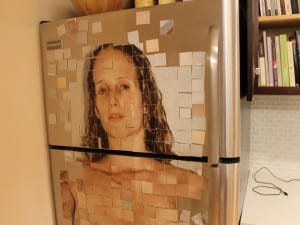“Days of tensions, brite nites of dreams” (Etchells, 1999) is a simple sentence that brings to light the sometimes tense atmosphere of life and the relaxed ‘brite’ nature of dreams. Reading this sentence lead me to think about the mixture of the two, the contradiction of relaxation and tension, which ultimately lead me to think about the contradiction between dreams and nightmares. In the session on Tuesday we began to discuss the contradiction between dreams and nightmares and working with the concept of a non/abusive parent figure. With this we were discussing the idea of having a kind ‘parent’ and having a nightmare emerge from the wardrobe, then we could flip this idea on its head by having an abusive parent and then having a dream or imaginary friend coming from within the wardrobe. This would also play with the idea that there are children who are perfectly safe in their reality yet look at a wardrobe with fear, as apposed to those children who use the method aren’t safe with the people who they are supposed to trust the most and use a wardrobe as a method of escape.
This conversation then moved on to the connotations of a bedroom, and the differences between the connotations of an adult’s bedroom and a child’s. How would an audience member feel if they were read extracts of a beloved children story, inter-mixed with the adult content of a book like 50 Shades of Grey?
As many of you will know the content within the book 50 Shades of Grey, written by E.L James, is quite obviously for adults. A parent would not allow one of their children to read this type of novel due to its content being ‘adult’. When reading 50 Shades of Grey, people don’t find content that easily relates to children, however when people read a child’s story they constantly search for a deeper meaning behind the text that can link to an adult’s lifestyle. Many people have analysed the tale of Alice in Wonderland in an attempt to do exactly that; to see if there is any deeper meaning to the text then it just being a child’s story.
As many people will already know the story was written by Charles Lutwig Dogson under the pseudonym Lewis Caroll. It is widely thought that Charles Dogson created the story Alice in Wonderland for the Liddel children who had a daughter named Alice, who was the youngest of three girls. “The theme with Alice growing and shrinking into different sizes could reflect the ups and downs of adolescence with young people sometimes feeling adult and sometimes quite the opposite” (Maata, 1997) which indicates that teenage thinking is really the confusion of having childish thoughts mixing together with new adult ones. “Some people have gone very far in their claims that Lewis Carroll wrote the stories while influenced by opium. They say the fifth chapter with the smoking Blue Caterpillar is about drugs.” (Maata, 1997) which is another indication of the adult world mixing with a child’s. It’s strange that a chapters of the book, which seem so colourful and suitable for the imagination of a child is considered to have been induced from the use of a drug. A drug being another thing that we would not expect to be present in a child’s world, in fact being behind the creation of a children’s story seems to be a rather confusing concept.
Perhaps in the moments in between being put to bed and getting out of it we could use a projector, coming from the wardrobe, showing clips of different children and adult films and programmes in order to highlight the differences between the two. It would seem to me that there is a generally accepted concept for a child’s bedroom and an adults bedroom, perhaps this mixing of the two would suggest a teenagers bedroom. Showcasing the in between time when a person is leaving behind their childhood, and becoming an adult, showing the confusion of thought that is often associated with that process.
Work Cited:
Etchells, T (1999) Endland Stories London: Pulp Faction
Maatta,Jerry, (1997) http://www.alice-in-wonderland.net/explain/alice841.html Sweden; March. (last accessed 8/4/2013)


